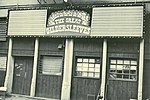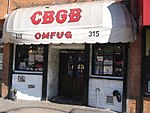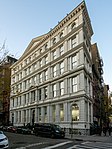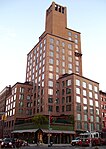Swiss Institute Contemporary Art New York

Swiss Institute / Contemporary Art New York (SI) is an independent non-profit contemporary art organization founded in 1986. SI is located at 38 St Marks Pl, the corner of Second Avenue and St Marks Place in the East Village neighborhood of Manhattan. Exhibitions include visual and performing arts, design, and architecture, with public programs spanning a wide range of topics. SI also has weekly public programming and education classes. Admission is free. Formerly a bank, the 38 St. Marks Place at Second Avenue building was designed by Selldorf Architects and includes exhibition space, an education and public programs floor, a library, and a usable rooftop. Printed Matter St. Mark’s bookstore is located on the ground floor.
Excerpt from the Wikipedia article Swiss Institute Contemporary Art New York (License: CC BY-SA 3.0, Authors, Images).Swiss Institute Contemporary Art New York
Bowery, New York Manhattan
Geographical coordinates (GPS) Address Nearby Places Show on map
Geographical coordinates (GPS)
| Latitude | Longitude |
|---|---|
| N 40.725656 ° | E -73.991794 ° |
Address
Bowery 325
10003 New York, Manhattan
New York, United States
Open on Google Maps






